#'40s music
Text
90: Joe Coleman // Infernal Machine
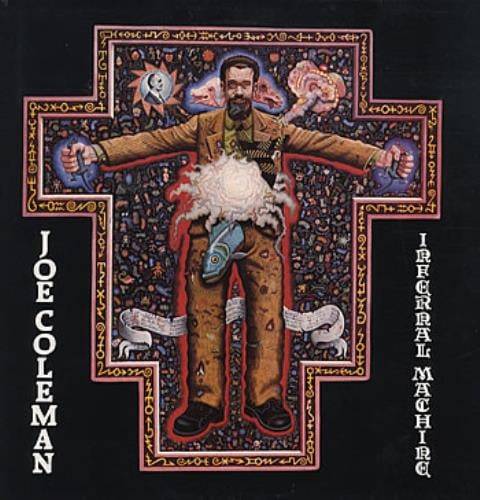
Infernal Machine
Joe Coleman
1990, Blast First
Joe Coleman emerged in the late 1970s from the alternative comix scene established by artists like Art Spiegelman (Maus), Kim Deitch (Waldo the Cat), and Bill Griffith (Zippy the Pinhead), but found greater notoriety as a painter and a shock artist. Here’s Spin’s Dean Kuipers on a performance (as his character Professor Mombooze-o) that resulted in one of Coleman’s numerous arrests:
“Boston, October 22, 1989. Reel after reel of ancient hardcore porno films flash onto a black screen onstage at BF/VF—the Boston Film/Video Foundation—grey and grainy, somebody else's fucking and sucking memories of indeterminate age. After 20 minutes, the hundred people in the audience are quiet and disarmed. The lights come up.
Joe Coleman instantly comes whapping through the film screen from behind, hanging upside down from a climber's harness attached to the ceiling, screaming and choking like a man condemned. This is the man everyone came to see. Green flames and acrid smoke belch from his chest as strapped-on explosives detonate under layers of shirt, ratty duck jacket and lab coat. Half a minute later, the booming and gnarling subside and Coleman's wife, Nancy, leaps out and douses him with goats’ blood to put out the fires. She cuts him down and he tears away what's left of the black screen to reveal a dead goat hanging upside down, twisting slowly. The goat is real. The odor of spattered blood and gunpowder seeps into the stunned crowd.
'Here are Mommy and Daddy!' cries Coleman, rushing to the front of the stage and pulling two live white mice from his pockets. He sits down on the edge of the stage and holds Mommy and Daddy up to his scorched beard and talks to them. Meanwhile, Nancy pulls out her Zippo and torches a cloth/plastic effigy of Coleman. The stage is consumed by fire as Joe screams at the squirming mice, 'I'll eat the cancer out of you!' and bites the head off Daddy, spewing it back into the audience. Then he snaps Mommy's head: hers he swallows.
This is Joe Coleman's stone ritualization of his mother's death. Four days earlier, she had died of cancer.
The befuddled firemen who arrive minutes later are sure that this must be the meeting of a satanic cult. As police investigators pick through the chaos of greening humans, brown smoke and bloody carcasses, the owners of BF/VF finger Joe and Nancy, then fire manager Jeri Rossi. All three are arrested and Joe is charged with—among other things—an old Massachusetts blue law charge that hasn't been used since the 1800s: Possession of an Infernal Machine."
(You can watch an excerpt of a similar performance in the 1988 pseudo-documentary Mondo New York, though I do not recommend doing so if you’re troubled by animal cruelty.)
The Infernal Machine LP is a figurative soundtrack to the Mombooze-o character, which he retired following the Boston bloodbath. Side one (“Homage to Mass Murderers”) intersperses vintage country and blues murder ballads with exploitation film clips and interviews with murderers Ed Kemper and Charles Manson. Side two (“Infernal Machine”) is a collage of clips from TV shows and ‘40s films noir, audio from Coleman’s Mondo New York performance, and early live recordings by NYC noise punks Steel Tips.
youtube
The overall effect is eerie, and there are some powerful juxtapositions. The way the clip of Kemper’s tearful description of murdering his own mother segues into Eddie Noack’s 1968 recording of “Psycho” underscores the song’s unnerving potency; tucked between relatively jaunty tunes by Bessie Smith and Tex Ritter, a long clip of character actor Don Russell’s genuinely moving performance as a kidnapped schoolteacher begging for his life from 1963’s The Sadist (based on the Charles Starkweather murders) seems to represent man’s powerlessness in a capricious universe. Side two is bookended by excerpts from the 1947 film Nightmare Alley, in which a series of disasters reduce cocksure Stan Carlisle (played by Tyrone Power) from his position as a carnival barker to the role of a despised geek who earns a meagre living by biting the heads off chickens in front of jeering crowds. The implication is that, as Mombooze-o, Coleman himself has been similarly forced into the role of a freak by the diseased contemporary world.
The LP includes a twelve-page booklet of Coleman’s paintings and, most interestingly, a picture-disc reproduction of details from its cover image, Portrait of Professor Mombooze-o. I’m not normally much interested in picture discs, but the sight of Coleman’s zombified head spinning on the table (or the dead fish bursting from his crotch on the flip) really does complete the package. It’s as a visual artist that Coleman’s chief gifts reveal themselves. His obsessively detailed paintings, which he works out over months and sometimes years using a single horsehair brush, are the most successful transference of an alt. comix sensibility to the gallery I’ve come across. If the work in R. Crumb’s classic Weirdo anthologies could feel like a mutated, devolved descendent of the feverish iconography of sixteenth century religious art, Coleman’s paintings are that mutant culture’s return to high art.
Coleman frequently conflates people like Charles Manson with Jesus Christ, saying in a ‘90s tour of his collection of oddities that he keeps a lock of Manson’s hair and a sample of Christ’s marrow. Falling back on the Blakean idea of a marriage of heaven and hell, he claims that if the pair’s DNA could be mixed in a clone it would create a perfect Messiah. However, the mingling of deviants and prophets in Coleman’s hagiographic art does not, as Coleman seems to mystically intend, elevate the former towards divinity so much as it pulls the latter earthward. Serial killers are, almost without exception, insipid creatures, powerless to explain their own behaviour with any real insight—as are for that matter, many holy men. Maniacs and religious figures are akin in the sense that each possesses intense evocative potential. A crazed killer’s actions, which seem both primal and alien, tear at the fabric of our notion of a shared reality. It is tempting to read their murders, being as superficially inexplicable as miraculous events, as signs or portents, the killers themselves as visionaries. Put another way, both religious phenomena and psychopathic behaviour create a void of ostensible meaning that humans are agitated to fill. Meaning does not arise from their actions but is imputed to them by witnesses. In Coleman, these boring, broken men who kill find a witness capable of making them a genuinely mythic force.
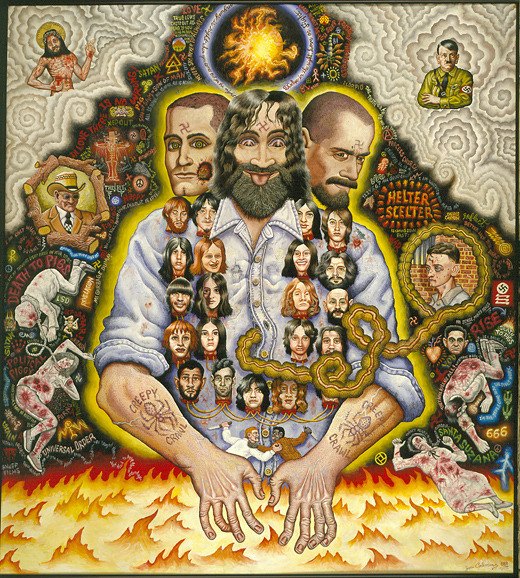
Portrait of Charles Manson, 1988
I find Coleman’s art as inspired and fascinating as I find his philosophy stunted and dull. In an interview with Richard Metzger on the BBC series Disinformation, Coleman says, with reference to mass murderer Richard Speck, “I don't want to kill anybody, but I want to express that pain. I want to express what he was trying to express. What if he didn't have to do that? And maybe, just maybe, art is a thing where you can do that.” Ten years previously, Coleman told an anecdote in Mondo New York about covering himself in blood and harassing random women at New York bars; when their boyfriends would intervene, he’d light the fuse on the hidden explosives attached to his chest and then calmly walk out of the bar in the confusion, enjoying the screams and smoke. Whether he’s spinning a yarn or recounting something he actually did, it’s clear he gets the same petty thrill out of terrifying strangers as the sickos (both real and fictional) excerpted on the Infernal Machine LP do. This doesn’t make him a monster, but it does clarify that when he talks about “expressing” their pain he also wants his share of their freedom to do violence. Of all the reasons it’s good for Coleman that he ended up an artist instead of a cut-rate David Berkowitz, the most telling is this: if he had, what artist of his quality would’ve wanted to take him as their subject?
90/365
#joe coleman#vinyl record#music review#picture disc#serial killers#charles starkweather#charles manson#manson family#richard speck#richard metzger#nightmare alley#alt. comix#comix#weirdo#mondo#'80s music#'50s music#'40s music#'60s music#'70s music
4 notes
·
View notes
Text

I’m so incredibly sane and normal about @tmnt-turtle-tunes and their new song you have no idea……
#Day be so fine#Then boom#This line stabbed me in the heart 40 times#how do I recover now#istg this fandom#these turtle#these tunes#kdmbdgejejdbdhdkdmmd#cas fanart tag#somerandomdoodles#cas music#rottmnt#rise of the tmnt#riseofthetmnt#leonardo#future leonardo
4K notes
·
View notes
Text

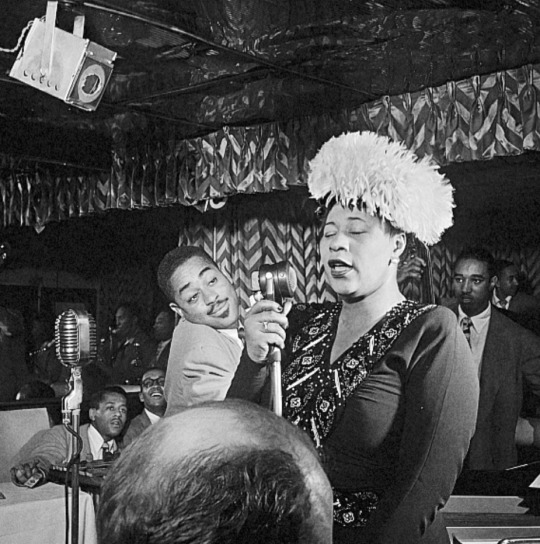
Ella Fitzgerald & Dizzy Gillespie, 1947 ♡
#ella fitzgerald#dizzy gillespie#jazz music#jazz#black vintage#40s fashion#1940s#40s#black love#black girl aesthetic#soft black girls#70s#70s style#70s vibes#70s vintage
1K notes
·
View notes
Text

2K notes
·
View notes
Text
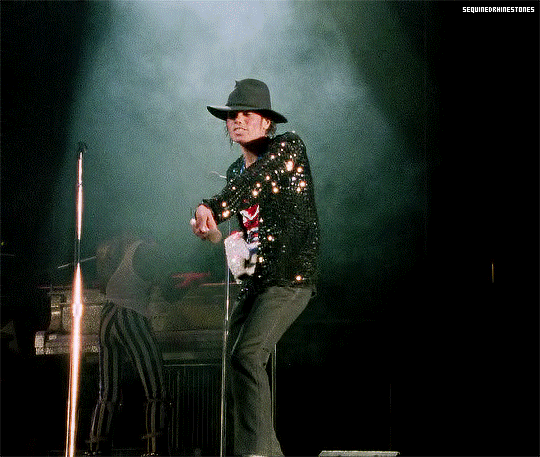
MICHAEL JACKSON // (03/∞) Thriller 40: The Album That Changed It All
#michael jackson#80s#king of pop#thriller 40#thriller#useranimusvox#throwbackblr#usermusic#tuserlauren#dailymusicians#blogmusicdaily#80s music#userbbelcher#dance#african american#retro#throwback#pop music#musicians#sequinedgifs
224 notes
·
View notes
Text
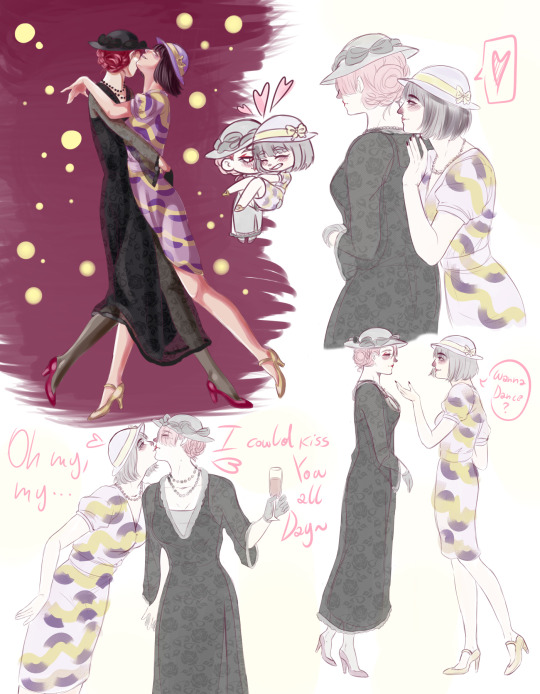
The new outfits made me insane

I HAD TO DRAW THEM BEGIN WIVES C'MON
#bungo stray dogs fanart#digital art#bungou gay dogs#bsd kouyou#ozaki kouyou#bsd yosano#yosano akiko#kousano#yosano x kouyou#I love drawing them like two wives in the 40s/50s#the lesbians ever#let them dance and kiss while soft jazz music plays in the background
321 notes
·
View notes
Text
jonah magnus is a massive britney spears fan and if martin hadn't distracted him during the unknowing he would've been up in his office, watching everything go down, listening to circus.
#his music taste consists britney spears and some really fucked up shit that isn't even spotify and you have no idea how he found it#and nothing else.#also this is funnier if you know my interpretation of how he looks#just imagine the most boring plain guy ever. the personification of paperwork. no earrings no colorful suits nothing.#most average 30-40 year old man in the world.#but he's a massive britney spears fan#tma#the magnus archives#tma headcanons#tma shitpost#tma spoilers#tma s3#jonah magnus#elias bouchard#martin blackwood
243 notes
·
View notes
Text

Today in Hip Hop History:
Rapper’s Delight by The Sugarhill Gang became the first Hip-Hop single to reach the Billboard Top 40 January 5, 1980
#today in hip hop history#todayinhiphophistory#hiphop#hip-hop#hip hop#hip hop music#hip hop history#music#history#rap#rapper's delight#hip hop culture#music history#billboard top 40#1980
249 notes
·
View notes
Text
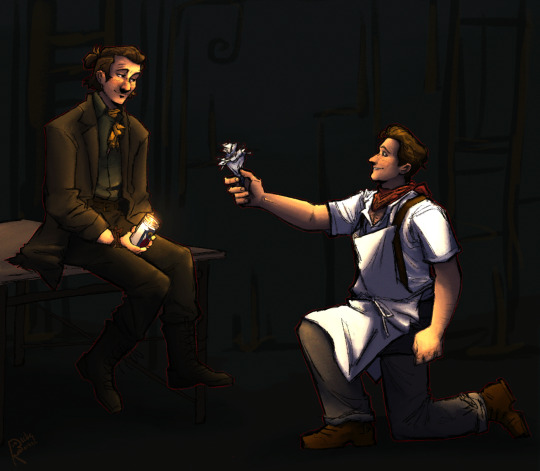
So- Spytown?
I’m in love with this au so much
Inspired by @dxppercxdxver ‘s Spies Are Forever/Hadestown AU. Also by @szollibisz incredible, just out of this world art, and @smytherines many, many text posts about it from the past few days.
#ignore the shitty background#and mid lighting#I do what I want#and what I want is to half ass those parts#I just really wanted to finish this bc I love the au so much#was listening to Hadestown while drawing this#did you know there are 40 tracks to that musical???#that’s so many!#y’know fun fact#I have yet to read the fics this is based on#trust me I’ll read this week I swear#but yeah this was fun#what great musicals#the both of them#btw lemme just say I’m in love with hadestown’s set#so fuckin cool#ok yeah I’m done now#spies are forever#hadestown#agent Curt mega#Curt mega#owen carvour#joey richter#tin can bros#spytown#my art#:)
163 notes
·
View notes
Text
332: Talat Mahmood // Spring Blossoms
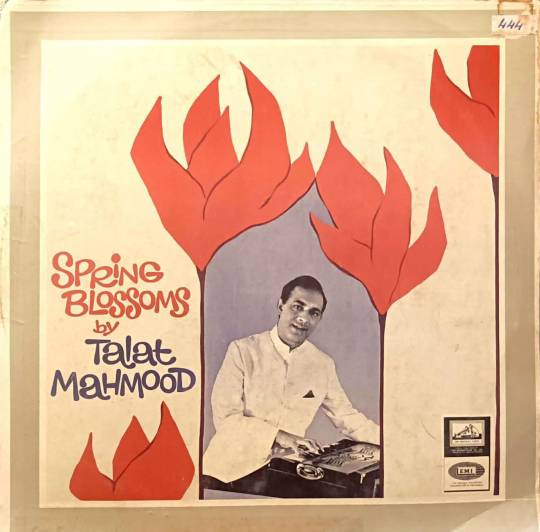
Spring Blossoms
Talat Mahmood
1967, His Master's Voice
“Handsome, debonair Talat Mahmood has been the idol of listeners for the last several years. His mild mellow voice and expressive style makes him ideally suited for putting over on disc, lyrics with soulful poetic contents. The Geets and Ghazals rendered by him on this disc once again establish that he is the King of the Ghazal-singers and there is none to beat him in style and superb execution.”
That’s how a note on the back of the Spring Blossoms sleeve puts it, and I’ve few qualms. Mahmood’s voice is indeed as smooth as they come, and there is plenty of soul to these numbers, though the word several there is doing some strange work—by 1967 Mahmood had been a major star for a quarter century!
I’ve covered a couple of ghazal-related records in this series (see here and here), but as a refresher, the ghazal is a form of Arabo-Persian poetic ode (classically a simultaneous address to an absent lover and to God) that has remained popular in the East for nearly 1,500 years. The ghazal is based on metrically regular rhyming couplets, a repetitive structure which makes it easy to adapt to a musical form. Ghazals are found in both Indian art and pop music, and most of the legendary Bollywood playback singers (including Asha Bosle, Mohammad Rafi, and Lata Mangeshkar) had many in their repertoires.
The ghazal’s subject matter is inevitably rather blue, but they are also often celebratory in a mystically existential kind of way—life’s pain cannot be avoided, but a poet is allowed to twirl while he displays his wounds and counts his jutting ribs. In Mahmood’s case, any discomforting sorrow is pillowed by the gentle, velvet quaver in his voice. This is music which releases tears without leaving marks, like a bloodless surgery (don’t talk to me about reiki). Mind you, I don’t mean that as an attack on its sentimentality. Daily life for Mahmood’s audience was hard and tiring, and the opportunity to have their emotions tenderly exercised by beauty is a fine thing. These people didn’t need to have catharsis thrust upon them by the kinds of sonic or poetic terrorism that I, a sheltered western pervert, occasionally require to feel feelings. But I also enjoy this album a lot!
Spring Blossoms is quite pop for the standards of its pre-rock ‘n’ roll time and place, which is to say that it is slow, sweet, and elegant in an almost courtly way that has more in common tonally with western light classical or Eastern European folk than it does the Anglo-American pop of the period. Great titles too: “Those Who Listen to Me While Hugging Me, Know That My Love is Beautiful” sounds like Explosions in the Sky doing kids music, while “I Am Drunk, I Am Naked” could be either Rumi or Viagra Boys.
332/365
#talat mahmood#ghazal#playback#playback singer#bollywood#indian music#geets#'60s music#'50s music#'40s music#lata mangeshkar#asha bhosle#mohammed rafi#music review#vinyl record
4 notes
·
View notes
Text
Whumper always played music while they did their evils. It rattled throughout whumpee's prison cell, reverberating in their ears, the melodies mixing with their blood as it dripped to the floor. Long after their rescue, whumpee still fears going out to the store, or even to a cafe, lest they be playing a song that sends them right into a flashback.
#whump prompt#did whumper listen to top 40 so every grocery store is a minefield?#or did whumper listen to obscure music that strikes whumpee when they least expect it#can whumpee ever enjoy music again?#or do they reclaim music and use it to help them through their recovery?
167 notes
·
View notes
Text
tagged by @arisingonmorningsinnocent
Rules: shuffle your On Repeat playlist and post the first 10 tracks, then tag 10 people
It's All Futile! It's All Pointless! by Lovejoy
In the Shadow of the Western Hills by the Mountain Goats
Nobody by the Crane Wives
Achilles Come Down by Gang of Youths
Never Quite Free by the Mountain Goats
A Burning Hill by Mitski
Hast Thou Considered the Tetrapod by the Mountain Goats
Be Calm by Fun.
Autoclave by the Mountain Goats
His Theme by Toby Fox
tagging @spiritunwilling @circuit77 @risingape @existentialterror @scientificalstories @erstwhilesparrow @adhdo5 @roundearthsociety @lepertamar @wolffyluna and anyone who sees this and wants to-- feel free to say i tagged you ^_^ and on the flip side if you were tagged and don't want to do it feel free to not!
#this is to say: i have pretty basic taste EXCEPT when it comes to the mountain goats. i have good tmg-related taste#which is related to tmg songs being 40% of the list#also i want to listen to in the shadow of the western hills a couple times now#feral cats out by the trash cans / to the true believer everything's a sign! scrape the pigments from the baseboards#therapists dni#trying to decide on people to tag was so hard bro ;-; what a joyous difficulty though!#o to have Too Many people on tumblr you're friends with and curious about the music tastes of!#i considered tagging mutuals i haven't talked as much to as well but i am too shy... alas#know that if you are my mutual i am tagging you in my heart & curious about your music taste though
463 notes
·
View notes
Text
guysguysguys. cloud boogie song SLAPS.
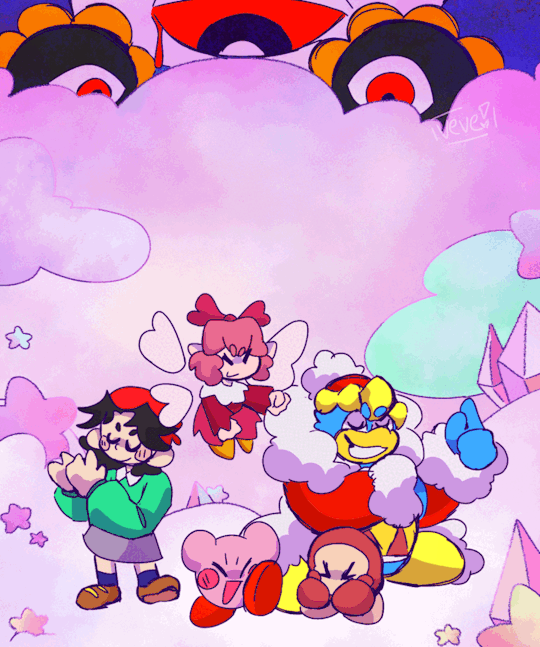
kirbytober day 25: favorite song/possession
#I HAVE THE AUDIO FILE BUT TUMBLRS NOT LETING MW UPLOAD IT#anyways. its boogie time#k64 music goes hard fr#BONUS!! try timing the music with the gif its really cool#dark matter is in there this counts as possession ok#i refuse to change my fav song just to fit the prompt this song is perfect in every aspect#this and sky tower are my favorites mmmmm#kirby series#kirby#waddle dee#bandana waddle dee#in my heart that is him...#king dedede#adeleine kirby#ribbon kirby#veves ultra cool art#kirbytober#kirbytober2023#this is 40+ layers on ibpx aaa#forgot some char tags ->#zero two kirby#dark matter kirby#Spotify
389 notes
·
View notes
Text

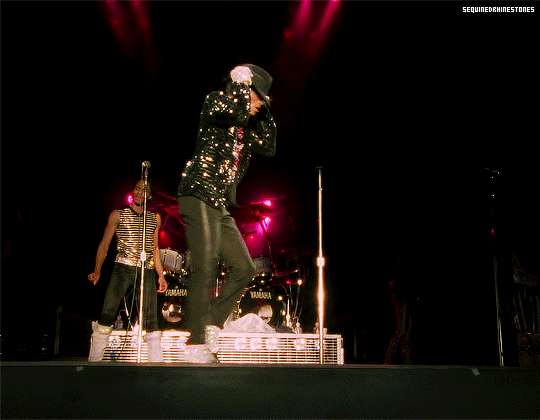
MICHAEL JACKSON // (01/∞) Thriller 40: The Album That Changed It All
#michael jackson#80s#king of pop#thriller 40#useranimusvox#usermusic#junkfooddaily#userbbelcher#throwbackblr#useroptional#tuserlauren#dailymusicians#blogmusicdaily#userstream#80s music#moonwalk#dance#the jacksons#billie jean#sequinedgifs
371 notes
·
View notes
Text
TWF fans have a strange habit of, for lack of a better word, woobifying Mr. Walten.
I think a lot of you seem to take this series a lot less serious than it actually is, and those same people have a very bad habit of making Jack out to be a saint. He's just a normal guy. Just because he loves his family doesn't mean he's some sweet and perfect guy who has no flaws. I never see any of you discuss or portray his anger issues that Martin has mentioned numerous times.
You all blatantly ignore the fact that Sophie's only memories she retained of him were that he was angry and he worked all the time. Just because he loves his family and didn't abuse them doesn't mean he's perfect. To deny him of these flaws take away what a dynamic character he's being written to be.
We know Felix sucks. We all know this because no one shuts up about it. That's his best friend of 20 years, someone he chose to have around his family, and someone he chose to start a business with. Felix's actions don't reflect on Jack, obviously, but you have to think about the fact they are best friends of 2 decades.
The small bit we know about Jack and what things Martin has let on to his personality over time is very different than what everyone makes him out to be, and it's strange. If you choose to ignore that Jack is just a normal middle-aged man in the 70s, that's on your own inability to actually like the character that's there.
#I could continue about this rant but truly it's grating on my very last nerve#i remain the only guy on this site that likes the workaholic chainsmoker 40 year old man#you guys do realize a guy can be goofy and love his family and also have flaws#does anyone remember when martin said that jack and felix hang out at bars together? we ignoring that?#just like how we ignore the sophie's memory of him on the site?#or how martin has said when jack dislikes something he actively shits on it (cartoons fashion choices music etc)#its weird to make him out to be some poor saint of a father who has zero flaws and his only personality traits are i love my wife !!!#him being a normal human with a multifaceted personality makes what happened all the more sad and realistic. he was a normal guy#with a normal life that was torn apart in a horrific unforeseeable accident. let him be dynamic. let him be an actual character and not jus#some goofy cartoon funny man.#rant over#twf#the walten files#jack walten#🥃.txt
113 notes
·
View notes
Text


Fred Astaire and Judy Garland - Easter Parade (1948)
#fred astaire#judy garland#easter parade#40s musicals#MGM musicals#irving berlin#charles walters#40s movies#1940s#1948
145 notes
·
View notes